Facebook Ad Size 2023: What You Need to Know Now and the Upcoming Year
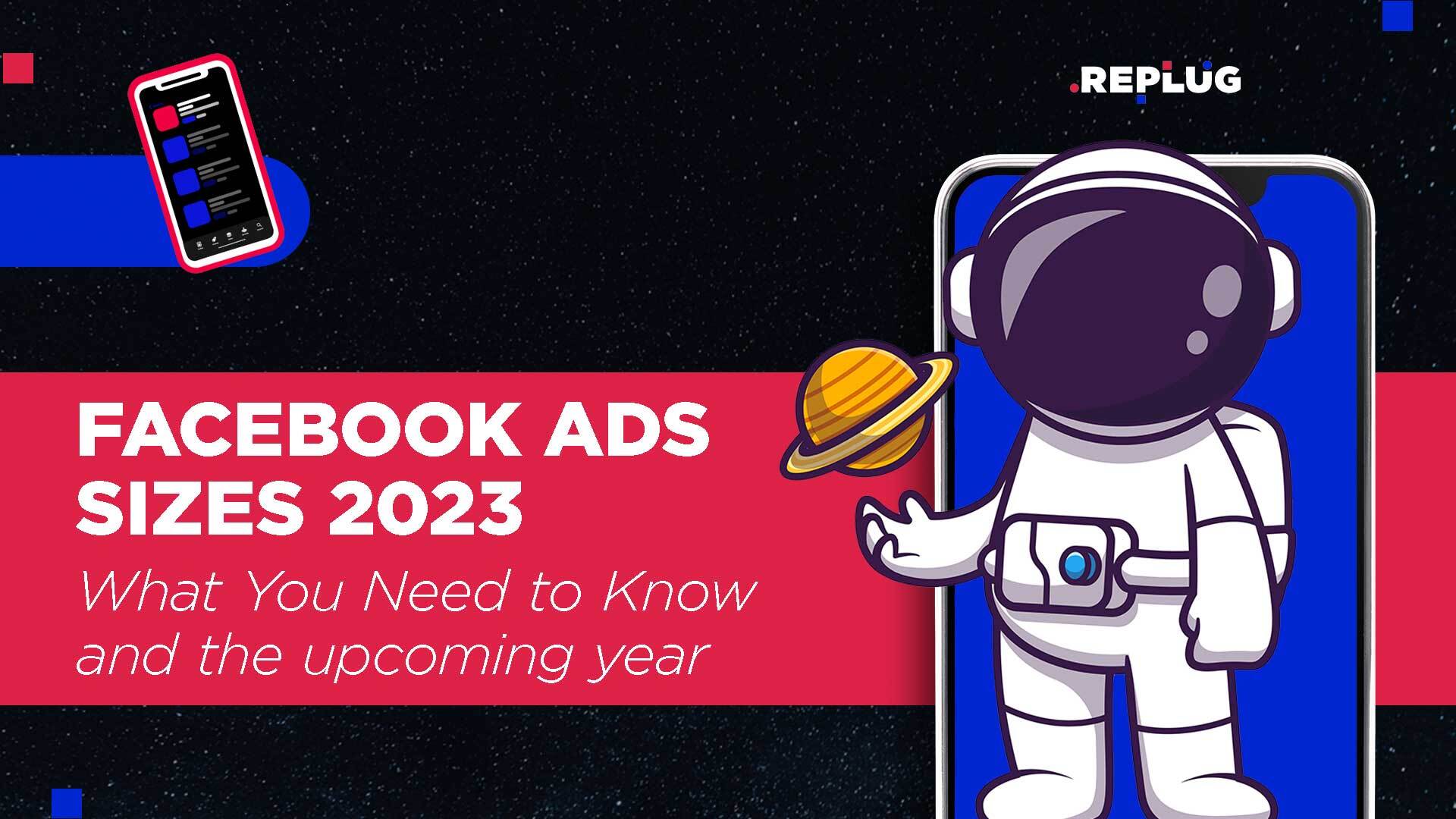
Facebook continues to dominate the world of social media platforms, with over 3 billion monthly active users as of 2023. You must understand the intricacies of Facebook ad sizes and specifications to make the most of your advertising efforts on Facebook.
Facebook has evolved its ad sizes to cater to both the desktop and mobile user experience, providing advertisers with a myriad of opportunities to reach their target audience effectively. This comprehensive guide will walk you through the various Facebook ad sizes, their best practices, and key tips for a successful advertising campaign in 2023 and 2024.
The Facebook Ad Types
Before we delve into the specific ad sizes, it’s essential to understand the various ad formats available on Facebook. As of 2023, the most common ad types include:
- Image Ads: these are single-image ads that can be used to showcase your products or services. They are available in various sizes and can appear in users’ feeds.
- Video Ads: video content is highly engaging, and Facebook offers several options for video ads, such as in-feed videos, stories, and more.
- Carousel Ads: these ads allow you to showcase multiple images or videos within a single ad unit, each with its own link.
- Slideshow Ads: slideshows are a way to create video-like ads from a series of images, making them suitable for businesses without video assets.
- Collection Ads: this format is designed for e-commerce businesses and enables you to display a collection of products in a visually appealing way.
- Facebook Stories: full-screen, temporary ads that pop up in the Stories section, offering a visually impactful way to connect with users for a limited time.
- Facebook Reels: they are short video ads that appear in the Facebook Reels feed, perfect for engaging and entertaining the audience.
Now, let’s explore the specific ad sizes for each format.
Understanding the Importance of Facebook Ad Sizes
Facebook ad sizes are not just about dimensions; they play a main role in how your ads appear to users.
The right ad size ensures your content looks appealing, loads quickly, and remains consistent across different devices and placements. Therefore, staying up to date with Facebook’s ad size recommendations is crucial for a successful advertising campaign.
Related: Facebook Automated App Ads: Should You Try It?
The Facebook Feed Ad Sizes in 2023 and 2024
As of 2023, Facebook offers a variety of ad formats and placements, each with its own recommended ad size. Let’s delve into the specifics of these ad sizes when it comes to Facebook Feed:
Image Ad Sizes
Image ads have gained immense popularity on Facebook, primarily due to their directness and the ease with which they can be produced. They provide a visual focal point that can quickly communicate a brand message, special promotion, or feature a product.
- Dimensions: the recommended image size is 1200 x 628 pixels. This size ensures that the image is displayed with clarity and precision across devices.
- Ratio: the ideal image ratio is 1.91:1. This ratio balances width and height to create an image that is visually appealing and aligns with Facebook’s platform standards.
- Formats and Size: Facebook supports both JPEG and PNG formats, with the latter being ideal for graphics with transparency. The maximum allowable file size is 30MB, ensuring the platform remains responsive and user-friendly.
- Platform Considerations: one vital aspect to consider is Facebook’s dynamic display adjustments. The platform might modify the ad’s aspect ratio based on where it is viewed, for instance, on mobile devices versus desktops. Hence, it’s crucial to test and optimize image ads for both.


Image ad example (source)
A complete table of the Facebook Image ad specs:
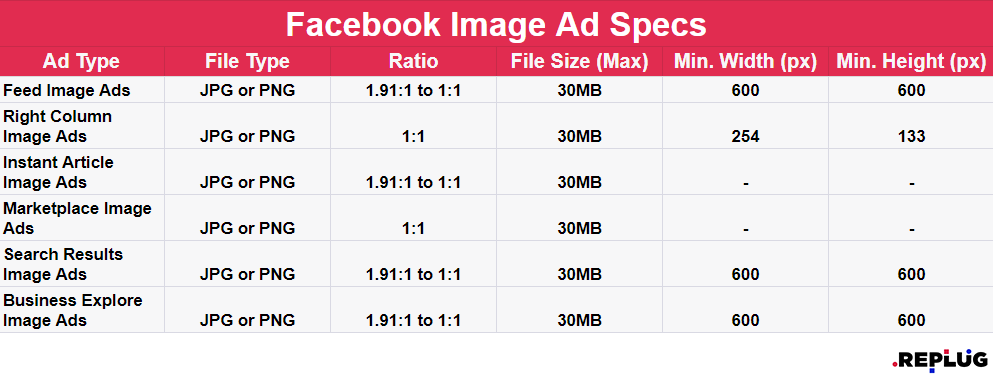

Video Ad Sizes
Video ads are an excellent medium to capture the audience’s attention on Facebook. They enable brands to convey their message dynamically, harnessing visuals and sound.
- Aspect Ratios: there are multiple recommended aspect ratios – 16:9 (widescreen) is perfect for cinematic content, 1:1 (square) is universally appealing and takes up more screen real estate on mobile, and 4:5 (vertical) is optimized for mobile view without going full screen.
- Resolution: it’s essential to maintain a high-quality visual experience. Hence, videos should have a resolution of at least 720p. This ensures that the content is crisp and clear.
- File Size and Duration: the maximum file size allowed is 4GB, which provides ample room for high-definition content. As for the duration, advertisers can utilize up to 240 minutes, though shorter, more concise videos often perform better in terms of engagement.
- Mobile Optimization: given the massive user base accessing Facebook via mobile devices, videos should be designed with a mobile-first mindset. This ensures seamless playbacks and better engagement on smartphones and tablets.
A complete table of the Facebook Video ad specs:
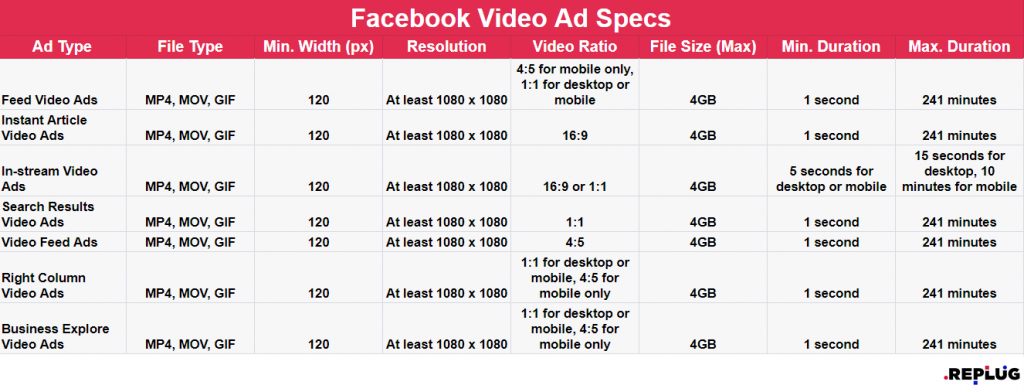

Carousel Ad Sizes
Carousel ads offer a unique format that lets advertisers display multiple images or videos within a single ad unit. This format is perfect for showcasing a range of products, telling a sequential story, or diving deep into a single product’s features.
- Dimensions: each image or video within the carousel should ideally be 1080 x 1080 pixels, making it a perfect square. This uniformity ensures a smooth scrolling experience.
- Ratio: a square 1:1 ratio is recommended. This ensures consistency as users swipe through the carousel, providing a cohesive visual narrative.
- Formats and Size: both JPEG and PNG are supported formats. Each card or segment of the carousel can be up to 30MB, allowing for high-quality visuals.
- Content and Cohesiveness: while you can have 2 to 10 cards in a carousel ad, ensuring that the images or videos are thematically connected creates a continuous and engaging user experience.


Carousel ad example (source)
A complete table of the Facebook Carousel ad specs:
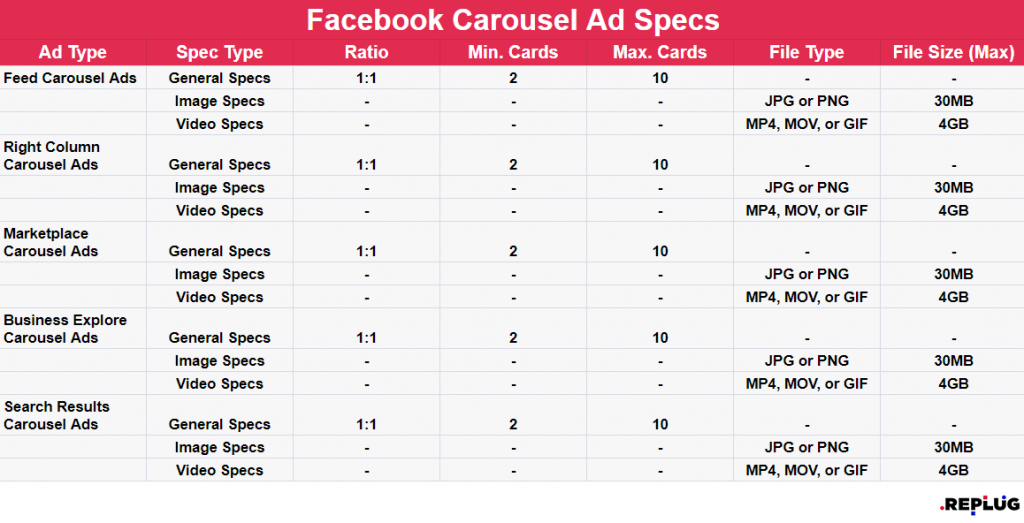

Slideshow Ad Sizes
Slideshow ads provide a resourceful solution, especially for businesses that might not have access to video content. These ads seamlessly convert sequences of images into a video-like presentation, offering dynamic storytelling without the complexities of video production.
- Dimensions: the suggested image size for a slideshow ad is 1280 x 720 pixels, which aligns with many standard screen resolutions and ensures clarity across devices.
- Ratio: advertisers have the flexibility to opt for either a 16:9 widescreen aspect ratio, ideal for landscape imagery, or a square 1:1 ratio, which is often more engaging on mobile devices.
- Formats and Size: the ad can be in JPEG or PNG format. A maximum file size of 30MB ensures that the slideshow remains easily loadable while retaining high-quality visuals.
- Usage Tip: maintaining consistency in the visual narrative while selecting images is crucial. This ensures that the slideshow tells a coherent and compelling story.


Slideshow ad example (source)
Collection Ad Sizes
Collection ads are tailor-made for e-commerce platforms, effortlessly showcasing an array of products in a captivating manner. This format is not just about displaying products but also about immersing users in a brand experience.
- Cover Image Dimensions: the introductory cover image sets the tone for the collection and should be sized at 1,200 x 628 pixels.
- Ratio: the preferred image ratio is 1.91:1, providing a broad view suited to product displays and brand stories.
- Formats and Size: as with many Facebook ad types, the JPEG and PNG formats are supported, with the latter being ideal for graphics with transparent backgrounds. The maximum file size is set at 30MB.
- Content Considerations: the ad can feature four or more products. The cover image must be captivating, drawing users into exploring the entire collection.


Collection ad example (source)
A complete table of the Facebook Feed Collection ad specs:
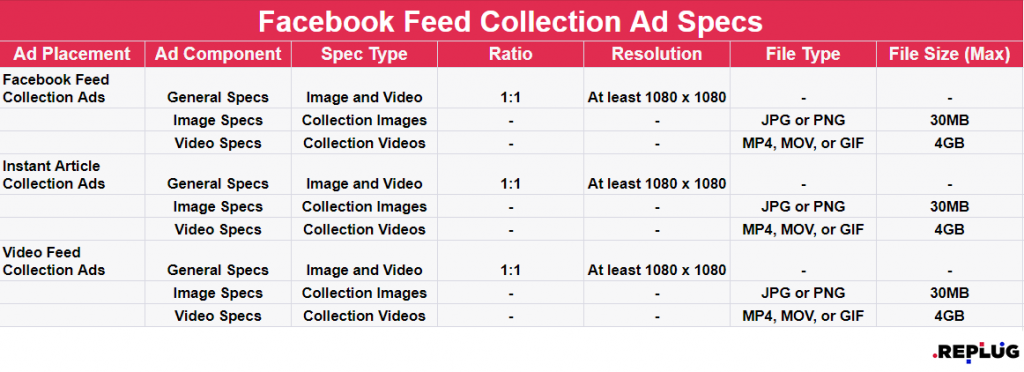

Facebook Stories Ads
Facebook Stories have become key for brands to connect with people. With its big screen style, it lets brands share their stories in a fun way.


Facebook story ad example (source)
1. Image Story Ads
Image story ads provide a visual feast on Facebook, making products shine full-screen.
- Aspect Ratio: a 9:16 ratio is ideal, explicitly crafted for mobile-first experiences.
- Resolution: images with at least 1080 x 1080 pixels ensure crisp visuals.
- File Size: limit the size to 30 MB for optimal loading and clarity.
- Duration: these images last 5 seconds unless swiped by the user.
Remember the 250-pixel border on the top and bottom, free of text and logos, for an unobstructed view.
2. Video Story Ads
A short, snappy video can create lasting memories. For the video story ads:
- Aspect Ratio: stick to the 9:16 format, which is perfect for mobile usage.
- Resolution: a minimum of 1080 x 1080 pixels ensures a vivid viewing experience.
- File Size: videos should be contained within 4GB.
- Duration: while videos can range from 1 second to 2 minutes, the ideal length is 15 seconds, after which they can be split into multiple story cards.


Note for Facebook Stories: be careful that you respect the safe areas. (source)
A complete table of the Facebook Stories ad specs:


Facebook Reels Ads
In the world of bite-sized video content, Facebook Reels stands out prominently, offering brands a refreshing space to showcase their persona. From community building and brand awareness to conversion-focused campaigns, Reels provides the tools to connect and engage.


Facebook reel ad example (source)
1. Video Reels Ads
Reels are a fun way for brands to connect with people. It’s like Stories, but they stick around longer. Reels mix easily with regular content, making it feel smooth and friendly.
- Aspect Ratio: the optimal ratio is 9:16, designed explicitly for vertical consumption.
- Resolution: ensure a resolution of at least 500 x 888 pixels for clear playback.
- File Type: Reels support MP4 and MOV formats.
- Duration: these short-form videos can range from 0 seconds to a full minute.
- Maximum File Size: videos should be kept within a 4GB limit.
- Sound and Captions: while not mandatory, they’re highly recommended for better accessibility and understanding.
Engage authentically with your audience, participate in trends, educate, or tell your story. With the ability to comment, save, share, or even skip these ads, Reels offer a user-centric experience.
2. Image Reels Ads
For those preferring static content, Image Reels Ads come to the rescue. A brilliant alternative to video, they allow brands to showcase their best visuals.
- Aspect Ratio: flexible ratios range from 1.91:1 to a square 1:1 format.
- Resolution: aim for a sharp resolution of at least 1080 x 1080 pixels.
- File Type: accepts both JPG and PNG images.
- Maximum File Size: images should be within the 30MB limit.
- Minimum Dimensions: maintain a width and height of at least 600 pixels.
A complete table of the Facebook Reels ad specs:


Best Practices for Facebook Ad Sizes
Understanding the recommended ad sizes is just the beginning. To create successful Facebook ad campaigns in 2023, you should also follow the best practices:
1. Create High-Quality Visual Content
Visual content is often linked to the first impression in a job interview. High-quality visuals in your ads signal to viewers that you’ve put effort into your presentation, just as a polished outfit would.
Viewers seeing blurry or pixelated content might make them think you’ve rushed your ad’s creation, which could negatively affect their perception of your brand.
Why it’s important: first impressions matter. High-quality visuals capture attention and foster trust, encouraging more interactions with your ads.
2. Design for Mobile-First
With the rise of smartphones, most users now access Facebook via mobile. An ad might look perfect on a desktop, but if it isn’t optimized for mobile, it could appear distorted, truncated, or even entirely misplaced on smaller screens.
Ensuring your ads are mobile-friendly isn’t a luxury – it’s a necessity.
Why it’s important: you want to meet your audience where they are, and nowadays, that’s on their phones.
3. Maintain Text-to-Image Ratio
Think about trying to read a book cover filled with text. Overwhelming, right? Similarly, Facebook ads cluttered with words can turn off users.
While you may have much to say, remember that Facebook is a visual platform. Your primary message should shine through your imagery, with text playing a supplementary role, offering clarity or a call to action.
Why it’s important: too much text can dilute your message and may even violate Facebook’s guidelines.
4. Experiment with Different Ad Formats
Think of Facebook’s ad offerings as tools in a toolbox. Each ad format has unique strengths, be it a carousel, video, or image. Continuously using the same ad format can result in ad fatigue, where viewers overlook your content because it becomes too predictable.
By diversifying, you can keep your audience intrigued, testing what brings the best engagement.
Why it’s important: different strokes for different folks, using a variety of ad formats ensures you cater to the diverse preferences of your audience.
5. A/B Testing
Imagine having two versions of a shirt, and you’re unsure which one looks better. A/B testing is similar, but for your ads. It means creating two versions of an ad with slight variations, perhaps in the image, headline, or ad copy.
By running both versions simultaneously, you can gather data on which performs better with your target audience. This iterative method is structured to refine your ad content, ensuring you always create the most engaging version.
Why it’s important: A/B testing reduces the guesswork. It’s a data-driven approach that lets you make informed decisions on content that resonates with your audience.
6. Use the Correct Call to Action (CTA)
Think of the CTA as the climax of your ad’s story; it’s when you prompt the viewer to take a desired action. Your CTA should be direct and irresistible whether you want them to shop, sign up, or learn more.
It’s not just about adding a button; it’s about aligning that button’s message with the overall objective of your campaign.
Why it’s important: a well-placed and clear CTA guides the user journey, leading to better conversion rates.
7. Ad Copy Matters
Ad copy is the voice of your visuals. It should be concise and punchy yet packed with engaging information relevant to your audience.
While visuals capture attention, the copy cements the message, providing context and urging action. It should work harmoniously with the visuals, filling gaps and reinforcing the message.
Why it’s important: compelling copy can be the difference between a scroll-past and a click-through.
8. Optimize for Speed
In the digital age, patience is a diminishing commodity. When users click on an ad, they expect it to load almost instantly. They’ll risk abandoning it if it takes too long, even if it’s just a few seconds more than anticipated.
Therefore, optimizing your ad files, especially large visuals or videos, ensures they load without delays, providing a seamless experience.
Why it’s important: faster-loading ads retain user interest, increasing their chances of interacting with your content and taking the desired action.
9. Ensure Ad Relevance
Your ad content should be more than just words and visuals; it should align with your target audience’s unique interests and preferences. By understanding and tapping into what truly matters to them, you ensure that your content resonates on a deeper level.
Why it’s important: a highly relevant ad isn’t just seen—it’s remembered and acted upon. It bridges the gap between brand messaging and audience interest, increasing the chances of meaningful interactions and conversions.
Related: Your 101 Guide to Facebook App Marketing
Facebook Ad Sizes and Responsive Design
Responsive design has become the standard as more users access Facebook from various devices. Facebook’s ad placements adjust to different screens, but you should still create ads that adapt seamlessly to varying ad sizes and placements. This means designing your ads to look great on desktop, mobile, and even larger displays like smart TVs.
By designing responsive ads, you ensure your ad remains engaging and readable, regardless of the user’s device. Ensure text, images, and videos are appropriately scaled and positioned to accommodate different ad dimensions.
Conclusion
Understanding the diverse range of the Facebook ad size 2023 and specifications is essential for brands seeking to optimize their campaigns. With options ranging from image ads to dynamic Facebook Reels, marketers have vast opportunities to resonate with their audience.
It’s not just about size but ensuring ads are visually appealing, load swiftly, and maintain integrity across devices. Staying updated with Facebook’s evolving ad size recommendations guarantees brands remain at the forefront of effective advertising.
Looking to scale your Facebook app marketing for 2023 and 2024? As mobile marketing experts, we masterfully navigate Facebook ad strategies. Get in touch with us.
Written by Jovana & Simon